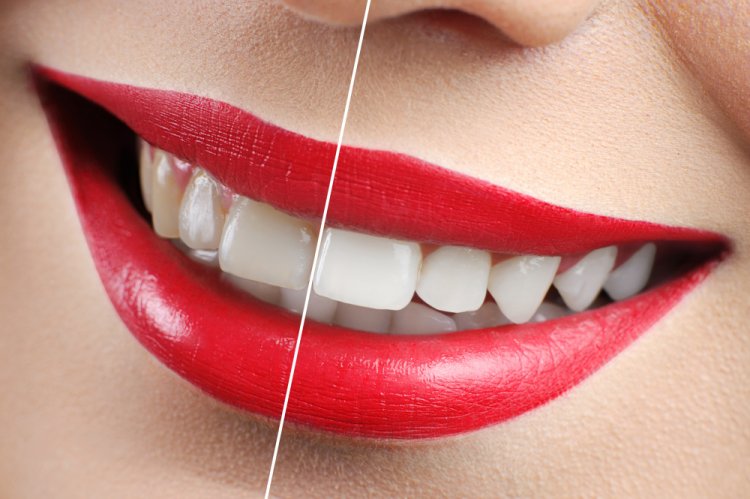Exploring Teeth Whitening: Types, Procedures, Precautions, and More
A brilliant, dazzling smile is often synonymous with health and attractiveness. Teeth whitening, a prevalent cosmetic dental procedure, aims to enhance the appearance of teeth by lightening their shade and eliminating stains and discoloration. This article provides an in-depth exploration of teeth whitening, covering its various types, procedures, precautions, and more.

Understanding Teeth Whitening:
Teeth whitening, also referred to as teeth bleaching, is a cosmetic dental treatment designed to improve the aesthetic appearance of teeth by brightening their color. It is widely sought after for its ability to rejuvenate smiles and boost self-confidence.
Types of Teeth Whitening:
In-Office Whitening:
Conducted under the supervision of a dental professional, in-office whitening involves the application of a highly concentrated bleaching agent directly to the teeth. This bleaching agent is often activated using a special light or laser to accelerate the whitening process. In-office whitening typically yields immediate and noticeable results, making it a popular choice for individuals seeking rapid improvement.
At-Home Whitening:
At-home whitening kits are available over-the-counter or through dental practitioners. These kits typically consist of whitening gel or strips that are applied to the teeth using custom-made trays. While at-home treatments may take longer to achieve desired results compared to in-office procedures, they offer convenience and flexibility, allowing individuals to whiten their teeth at their own pace and in the comfort of their homes.
Whitening Toothpaste:
Whitening toothpaste contains mild abrasives and chemical agents that help remove surface stains from the teeth. While not as potent as professional whitening treatments, whitening toothpaste can be effective for maintaining whiteness after undergoing professional whitening procedures. However, they may not produce significant whitening results when used alone.
Natural Remedies:
Some individuals opt for natural teeth whitening methods, such as brushing with baking soda, using activated charcoal, or rinsing with hydrogen peroxide solutions. While these methods may offer some degree of whitening effect, they should be approached with caution as they may cause enamel erosion or other dental issues if used incorrectly or excessively.
Procedure Overview:
The process of teeth whitening typically involves the following steps:
-
Dental Evaluation: Before undergoing a whitening procedure, it is essential to undergo a comprehensive dental examination to assess the overall health of the teeth and gums. Any existing dental issues, such as cavities or gum disease, may need to be addressed before proceeding with whitening.
-
Preparation: Depending on the chosen whitening method, the dentist may take impressions of the teeth to create custom-fit whitening trays for at-home treatments or prepare the teeth for in-office whitening by isolating the gums and applying a protective barrier.
-
Application of Whitening Agent: The whitening agent, typically containing hydrogen peroxide or carbamide peroxide, is applied to the teeth either by the dentist during in-office treatments or by the individual using custom trays for at-home treatments.
-
Activation (if applicable): In some cases, a special light or laser may be used to activate the whitening agent, enhancing its effectiveness and accelerating the whitening process.
-
Monitoring and Adjustments: Throughout the whitening procedure, the dentist monitors the progress and may make adjustments as necessary to ensure optimal results and minimize any potential side effects.
-
Post-Treatment Care: After completing the whitening treatment, individuals are advised to follow post-treatment care instructions provided by the dentist. This may include avoiding foods and beverages that may stain the teeth, practicing good oral hygiene, and attending follow-up appointments as recommended.
Precautions and Considerations:
While teeth whitening is generally considered safe and effective, there are several precautions and considerations to keep in mind:
-
Sensitivity: Some individuals may experience temporary tooth sensitivity following whitening treatments, particularly to hot and cold temperatures. This sensitivity usually resolves on its own within a few days.
-
Gum Irritation: Improper application of whitening agents or ill-fitting trays can lead to gum irritation or sensitivity. It is crucial to follow the dentist's instructions carefully and seek professional guidance if any discomfort occurs.
-
Enamel Damage: Overuse or misuse of whitening products can potentially damage tooth enamel, leading to increased tooth sensitivity and other dental problems. It is essential to use whitening products as directed and consult with a dentist if there are any concerns.
-
Effectiveness: The effectiveness of teeth whitening treatments may vary depending on factors such as the severity of staining, the type of whitening method used, and individual factors like genetics and lifestyle habits.
-
Not Suitable for Everyone: Teeth whitening may not be suitable for individuals with certain dental conditions, such as tooth decay, gum disease, or hypersensitivity, or those with allergies to whitening agents. It is essential to consult with a dentist before undergoing any whitening treatment to determine suitability and discuss alternative options if necessary.
In conclusion, teeth whitening is a popular cosmetic dental procedure that can significantly improve the appearance of teeth and enhance overall smile aesthetics. By understanding the different types of whitening methods, the whitening process itself, and the precautions to take, individuals can achieve safe and satisfactory results. However, it is essential to consult with a dental professional to determine the most suitable whitening option based on individual needs and preferences and ensure optimal outcomes.
#TeethWhitening #DentalBleaching #WhiteningProcedures #CosmeticDentistry #BrightSmile #ProfessionalWhitening #AtHomeKits #ToothDiscoloration #SmileMakeover #WhiteTeeth #HealthySmile #DentalCare #BeautyTips #OralHealth #DentalHealth #SmileConfidence #BrightenYourSmile #WhiteningTreatment #BeautifulSmile #DentalCosmetics #BrightenUp #DentalTips #PerfectSmile #SparklingSmile #WhiteningGel #WhiterTeeth #ConfidentSmile
Disclaimer:
The information provided in this article is for educational purposes only and should not be considered medical advice. If you have any health concerns or are experiencing symptoms, it is important to consult with a healthcare professional, such as a doctor or clinic, for proper diagnosis and treatment. Always seek the advice of your doctor or other qualified health provider with any questions you may have regarding a medical condition. Do not disregard professional medical advice or delay in seeking it because of something you have read in this article.
What's Your Reaction?





















